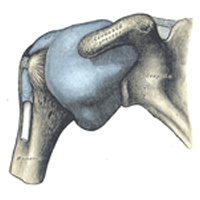Physical therapy can help patients experiencing frozen shoulder regain movement faster. If your initial pain doesn’t go away with usual pain relievers, it’s probably time to check with a physical therapist. That’s because it can take up to TWO YEARS to go away on it’s own! This is definitely not something to be ignored.
Adhesive capsulitis is more commonly known as frozen shoulder, and with good reason: It can render your shoulder so stiff, it’s almost impossible to button your shirt — that is, if you aren’t in too much pain to get dressed in the first place.
Where does this injury Come From?
In general it comes on after an injury to your shoulder or a bout with another musculo-skeletal condition such as tendinitis or bursitis. Quite often its cause can’t be pinpointed. Nonetheless, any condition that causes you to refrain from moving your arm and using your shoulder joint can put you at risk for developing this injury.
It affects 10-20 percent of people with diabetes according to the American Academy of Orthopedic Surgeons. Women are more likely to develop this injury than men and it occurs most frequently in people between the ages of 40 and 60.
Where does the diabetes come in?
Well, doctors still aren’t exactly sure. But they believe that excess glucose impacts the collagen in the shoulder. Collagen is a major building block in the ligaments that hold the bones together in a joint. When sugar molecules attach to the collagen, it can make the collagen sticky. The buildup then causes the affected shoulder to stiffen, and the pain prevents you from moving your arm. Ouch!
This injury has Three Stages:
FREEZING
Pain slowly becomes worse until range of motion is lost.
(Lasts 6 weeks to 9 months)
FROZEN
Pain improves, but the shoulder is still stiff.
(Lasts 4 to 6 months)
THAWING
Ability to move the shoulder improves until normal or close to normal.
(Lasts 6 months to 2 years)
Physical therapy is often very effective in treating frozen shoulder. If your initial pain doesn’t go away with the usual pain relievers, it’s probably time to check with a doctor. That’s because it can take up to two years to go away on its own! This is definitely not something to be ignored.
TREATMENT
Treatment focuses on controlling pain and getting movement back to normal through physical therapy. Sometimes surgery is also considered. Talk to your doctor about treatment options that are right for you.
PREVENTION
Because doctors don’t really understand the causes, it can be difficult to prevent them in most cases. Keeping your blood sugars under control is always key to avoiding all complications. Doctors have also found that people who’ve suffered an injury to their shoulder or stroke are also at an increased risk, because of the immobility the other condition has caused. If you have diabetes and have had a shoulder injury, talk to your doctor or a physical therapist about what kind of exercises you can do to make sure this doesn’t happen to you.
Written by the Therapy Team at Advanced Physical Therapy



